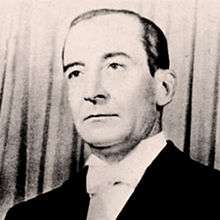Pedro Eugenio Aramburu
| Pedro Eugenio Aramburu | |
|---|---|
 | |
| 31st President of Argentina de facto | |
|
In office November 13, 1955 – May 1, 1958 | |
| Vice President | Isaac Rojas |
| Preceded by | Eduardo Lonardi |
| Succeeded by | Arturo Frondizi |
| Personal details | |
| Born |
Pedro Eugenio Aramburu Silveti May 21, 1903 Río Cuarto, Córdoba, Argentina |
| Died |
June 1, 1970 (aged 67) Carlos Tejedor, Buenos Aires, Argentina (assassinated) |
| Resting place | La Recoleta Cemetery |
| Nationality | Argentine |
| Political party | Unión del Pueblo Argentino (UDELPA) |
| Spouse(s) | Sara Lucía Herrera |
| Signature |
|
| Military service | |
| Allegiance |
|
| Service/branch |
|
| Years of service | 1922–1958 |
| Rank |
|
Pedro Eugenio Aramburu Silveti (May 21, 1903 – June 1, 1970) was an Argentine Army general. He was a major figure behind the Revolución Libertadora, the military coup against Juan Perón in 1955. He became de facto President of Argentina from November 13, 1955 to May 1, 1958. He was kidnapped by the radical organization Montoneros on May 29, 1970 and murdered, allegedly in retaliation for the June 1956 execution of General Juan José Valle, an army officer associated with the Peronist movement, and 26 Peronist militants after a botched attempt to overthrow his regime.
Military career
- He studied at the National Military College
- 1922: Sub-lieutenant
- 1939: Major
- 1943: Teacher in the Escuela de Guerra
- 1951: Brigadier
- Director of the Escuela de Guerra
- 1955: Commander in Chief of the Army
- 1958: Lieutenant general.
15 years of anti-Peronist political power
In September 1955, Aramburu participated in a military coup called the "Revolución Libertadora". He led the hardliners and assumed the Presidency of Argentina himself, on November 13, 1955, after the resignation of moderate General Eduardo Lonardi. Admiral Isaac Rojas, was appointed Vice-President.
The Revolución Libertadora which overthrew Juan Domingo Perón was triggered in part by the Perón's public confrontation with the Catholic Church over divorce laws, his actions towards the press, as well as the imprisonment of opposition leaders and economic instability. The Revolución Libertadora led to three years of military rule under Aramburu, who allowed elections to be held in 1958 (won by Arturo Frondizi.)
Aramburu's military government forced Perón into exile and barred the Peronist party from further elections. Known Peronists were persecuted and often imprisoned, or murdered; the mere mention of Juan or Eva Perón's names was declared illegal under Decree Law 4161/56. Perón lived in exile in Spain until 1973 under the protection of Generalísimo Francisco Franco.
After the end of his presidential term in 1958, Aramburu retired from the military career and devoted himself entirely to politics.
He ran for president in 1963, forming the "Union del Pueblo Argentino" (UDELPA, Union of the Argentine People), with the slogan: "Vote UDELPA and HE won't return" ("Vote UDELPA y no vuelve"), referring to Perón.
With the Peronists banned, the Presidential elections resulted in Arturo Umberto Illia becoming president, with Aramburu coming in third.
Yet the military retained much real power, censoring both Peronism and its leader. The fragility of Argentine democracy was shown when Illia was overthrown in 1966 by a military coup led by General Juan Carlos Onganía.
In all those 15 years, Pedro Eugenio Aramburu was popular with much of the press. He often gave his opinions on society and politics (especially in Gente magazine, representative of Argentine high society).
In 1970, he was mentioned as a possible Presidential candidate.
Montoneros
In the 1960s, rumors about Perón's return to Argentina were circulating daily. From his exile in Spain, his voice grew stronger and stronger. At the same time, leftist strength grew in Argentina as in much of South America. The example of Che Guevara influenced a generation of students in schools and universities that supported international socialism.
It was in this background that the terrorist group Montoneros, led by Fernando Abal Medina were formed to support Peron's return to Argentina.
Death
On May 29, 1970 at noon, Aramburu was snatched from his apartment in Buenos Aires by two members of Montoneros posing as young army officers. Montoneros dubbed the kidnapping Operación Pindapoy, after a famous company that produced citrus in the 1960s. Aramburu's disappearance kept Argentinian society on tenterhooks for a month before it was discovered that Aramburu had been murdered three days after his abduction, following a mock trial and his corpse hidden inside a farmhouse near Timote, Carlos Tejedor, in Buenos Aires Province. He had been shot twice in the chest with two different pistols.
In the following weeks, statements from the Montoneros flooded the media. Among other things, they claimed historical reasons for their actions such as "the murder of 27 Argentines after an unsuccessful Peronist rebellion in 1956," as the José León Suárez massacre. The executions had been described by journalist and writer Rodolfo Walsh in his novel Operación Masacre'."
In 1974, Aramburu's body was stolen by Montoneros. The corpse was to be held until President Isabel Perón brought back Evita Perón's body. It was also an act of revenge for the previous removal of Evita's body. Once Evita's body arrived in Argentina the Montoneros gave up Aramburu's corpse and abandoned it in a street in Buenos Aires.[1]
See also
References
- ↑ Negrete, Claudio R. (2010). "Canjeando muertos". Necromanía: Historia de una pasión argentina (in Spanish). Sudamericana.
External links
- Ejército Argentino (Spanish)
- Some speeches of Aramburu
- Information about Presidents of Argentina (Spanish)
- Braden vs Peron confrontation (Spanish)
- The official notices from Montoneros (Spanish)
- Find-A-Grave profile for Pedro Eugenio Aramburu
| Political offices | ||
|---|---|---|
| Preceded by Eduardo Lonardi |
President of Argentina 1955–1958 |
Succeeded by Arturo Frondizi |